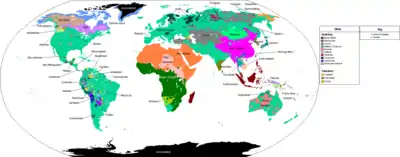Language family
Language families are groups of languages that are related to each other because they come from a common older language. The languages in such a family are similar in their vocabulary or structure.

For example, French and Spanish both come from Latin. Latin was spoken a long time ago, and some of the people who spoke it started to speak different ways - for the word "good", one group started saying "bueno" while another group started saying "bon". Most words are said a little differently in Spanish and French, so the two are called different languages.
Most languages belong to a language family, but some languages do not. These languages are called language isolates.
There also are constructed languages, such as Esperanto. Constructed languages are made for different reasons: making a 'world language', for fun, for use in fiction, etc.
Major language families
By number of languages
Ethnologue 22 (2019) lists these language families as "major". Each has at least 1% of all languages on Earth:
- Niger–Congo (1,542 languages) (21.7%)
- Austronesian (1,257 languages) (17.7%)
- Trans–New Guinea (482 languages) (6.8%)
- Sino-Tibetan (455 languages) (6.4%)
- Indo-European (448 languages) (6.3%)
- Australian [dubious] (381 languages) (5.4%)
- Afro-Asiatic (377 languages) (5.3%)
- Nilo-Saharan [dubious] (206 languages) (2.9%)
- Oto-Manguean (178 languages) (2.5%)
- Austroasiatic (167 languages) (2.3%)
- Tai–Kadai (91 languages) (1.3%)
- Dravidian (86 languages) (1.2%)
- Tupian (76 languages) (1.1%)
Glottolog 4.0 (2019) lists the following as the largest families, of 8494 languages:
- Atlantic–Congo (1,432 languages)
- Austronesian (1,275 languages)
- Indo-European (588 languages)
- Sino-Tibetan (494 languages)
- Afro-Asiatic (373 languages)
- Nuclear Trans–New Guinea (314 languages)
- Pama–Nyungan (248 languages)
- Oto-Manguean (180 languages)
- Austroasiatic (159 languages)
- Tai–Kadai (94 languages)
- Dravidian (81 languages)
- Arawakan (78 languages)
- Mande (75 languages)
- Tupian (71 languages)